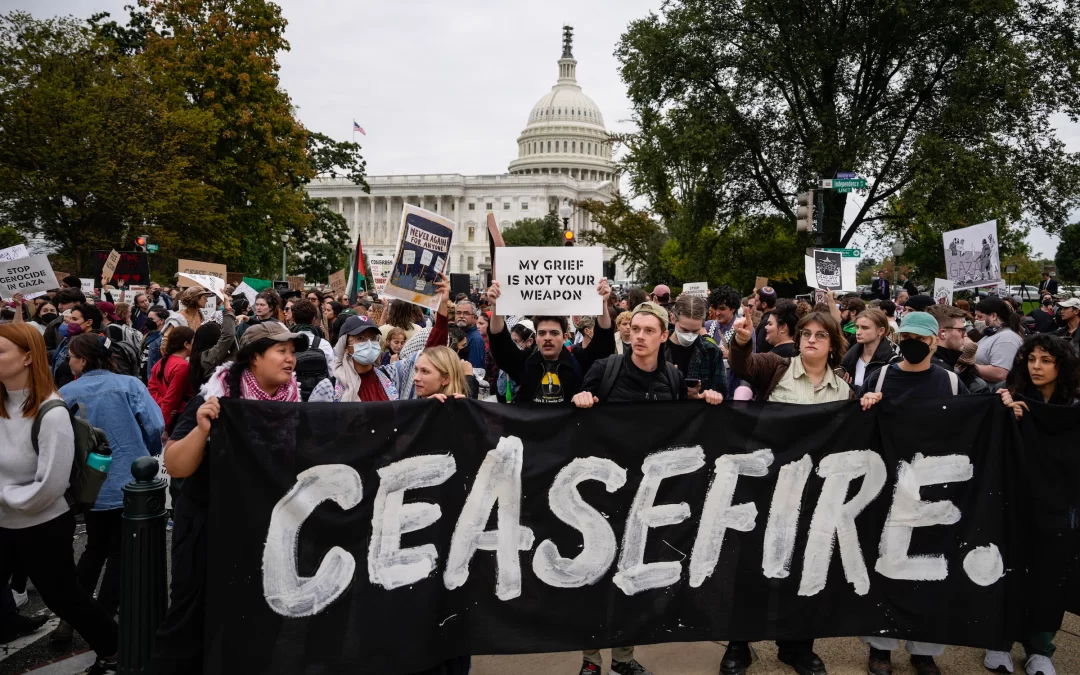I said to my heart, show me the way now. Help me to know what is mine to do amidst the great catastrophe — the death, suffering and ignorance that’s so much bigger than the latest war. Give me clarity and courage. Help me to see love and beauty amidst the destruction and suffering. I’m listening to you, so I may honor the grief, the care and compassion. So I may know what to do and who to be. Oh tender heart, resilient heart, show me the way from here.
For a long time now, morning tears have been a regular part of my mornings as I take in the headlines. Since the Hamas attack and the beginning of Israeli’s bombardment on October 7, the swirl of emotions and the tears have become a daily ritual.
Those of us willing to look are watching the death and destruction up close in real time like never before. Citizen reporters live stream it with cell phones—filming while Hamas killed and kidnapped people at a music festival, filming while Palestinians carry their dead and wounded, grieve, and dig the rubble with bare hands; filming the utter chaos of hospitals under siege, without water or electricity.
Practicing Peace in Times of War
Moments such as these bring forward the question that has been so helpful to me over the years: What is mine to do? Without making it a should, without limiting the possibilities or belittling any possible contribution I might make: What is mine to do?
My intuition and training tells me to keep my heart as open as possible, continue to bear witness, and hold the Big Picture. As support I returned to a little book that has meant a lot to me, Pema Chödrön’s Practicing Peace in Times of War.
War and peace starts in the hearts of individuals…..War begins when we harden our hearts, and we harden them easily….And if we don’t do the habitual thing, hardening our heart and holding tightly to certain views, then we’re left with that underlying uneasiness that we’re trying to get away from….That’s when the real journey of courage begins. This is the real work of the peacemaker, to find the soft spot and the tenderness in that very uneasy place and stay with it.
As I think about the root causes of war and violence and injustice—the Israel-Palestine conflict, the racism and harm of US immigration policy, the epidemic of gun violence—it’s clear to me that Pema Chödrön is indeed focused on “real work,” the very personal work that eludes easy answers, quick fixes, and the abdication of responsibility to leaders, legislators, and lawyers.
Groundswell at the Grassroots
When the very personal work of self reflection and self understanding is combined with curiosity, reflection, and understanding of the root causes of violence at the societal and political level, then an open heart and an open hand start to become possible. When that’s combined with the activism of so many, and “creative tension” builds to levels untenable to business as usual, then we have a transformational moment.
The constructive side of this terrible violence is the lifting up (when we go beyond the mainstream news) of the voices of people with the clarity of mind and heart to contextualize the violence and honor the humanity of all. Historians such as Ilan Pappé and Omer Bartov, journalists like Amira Hass, many artists and writers; and groups like Jewish Voice for Peace. They are all calling us toward a new day beyond the old paradigm of tribalism, colonialism, and violence.
Add to this the wisdom of people like Gabor Maté, with his emphasis on trauma, and then we have the humility and compassion to capitalize on the moment, to nurture new paradigms rooted in our shared humanity. Are we are in such a moment now?
There have never been more people who understand that the illusion of separation is the biggest, most deadly lie of all. Never been more people who understand that continued destruction of ecosystems and destabilization of the climate is collective suicide. Never been more people actively working in support of Life.
A shared focus on upholding Life gives us a constructive place to focus our attention and energy.
It is nothing less than an evolution of human consciousness and, yes, it can be hard to see and even harder to appreciate in times of crisis. But I believe it’s real.
Seeing some rays of sun doesn’t mean denying the darkness—the ugliness and the challenges we face—it simply means that we can see a fuller picture. And that bigger picture can help keep our hearts open and be a remedy for despair and hopelessness.
The tender, resilient heart continues to be our truest guide. The heart has a wisdom the mind can never attain. May you listen to your heart now and connect with who you want to be and what is yours to do, whatever that might be.
Blessings,
Scott
Photo credit: Drew Angerer/Getty Images


Mahalo Scott! I appreciate you sharing your tears, your compassion and some amazing folks and resources.
Thank you Dona! We’re all in it together.